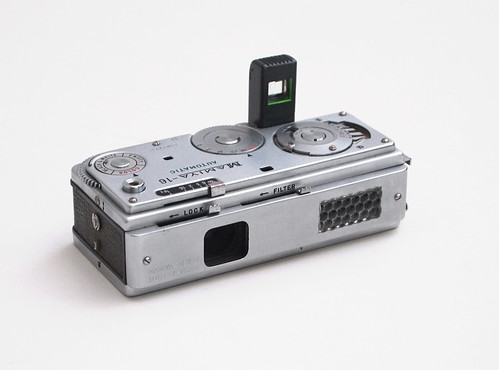 |
| Mamiya-16 Automatic |
In photography, the term
subminiature refers to a class of cameras using a film format smaller than 35mm (as, when introduced, 35mm film was considered a 'miniature' format compared to plates or sheet films). Although subminiature cameras pre-date the second world war, their popularity was greatest in the immediate post-war years, most notably in Japan, with the
Hit camera and its various copies. These cameras used 17.5mm film and were generally 'point-and-shoot' types, with a single shutter speed, aperture and fixed focus meniscus lenses. The desire for greater sophistication and control was met with a generation of cameras using 16mm film which emerged in the 1950s and 60s. These cameras were designed around proprietary cassettes or cartridges, which in most cases were incompatible with those of other manufacturers. These various subminiature standards were essentially supplanted by Kodak's
110 format, which utilised paper-backed 16mm film in plastic cartridges. With Kodak behind it, the 110 cartridge became widely adopted, with many manufacturers producing cameras for it.
The
Mamiya-16 Automatic was first produced in 1959, and evolved from previous Mamiya-16 subminiature cameras; the 'Automatic' in the name refers to the use of the selenium meter to determine the correct aperture, done
manually, but more convenient than the use of hand-held light meters. The inclusion of the meter makes the Mamiya-16 Automatic about half as big again as the preceding models, but it is still only 104mm wide by 32mm high and 48mm deep. The camera is of all-metal construction, and feels reassuringly heavy for its small size: this is a fully featured camera of its day. All the user controls are located on the top plate of the camera, as seen clearly set out in the picture below.
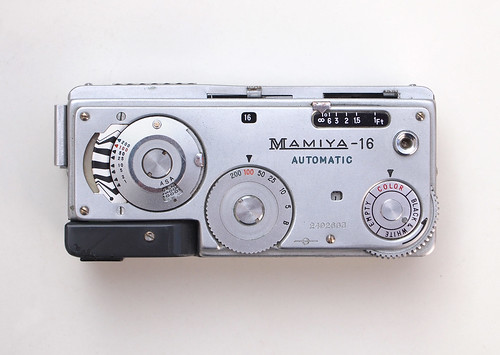 |
| View of the Mamiya-16 Automatic top plate |
The camera has a 25mm f2.8 Mamiya-Sekor lens. Focus is by estimating the subject distance which is set on the slider above the camera's name. Framing is done by the bright line viewfinder which folds down when not in use. Many subminiature cameras have a fixed focus lens: the main rival to the Mamiya-16 series seems to have been the
Minolta-16 cameras,
which were fixed focus, until the last Minolta subminiature model in the 1970s, the
QT. As the lens is of short focal
length, it has a very good depth of focus, and there's a small circle to indicate the hyperfocal distance between 6ft and infinity. The lens is protected by a sliding cover, which also locks the shutter when closed. Shutter speeds run from 1/200th to 1/5th and B (early production models also have a 1/2th second) and are set in the large wheel in the middle of the top plate. Apertures are selected by rotating the exposure calculator dial using the semi-circular tab. The exposure meter has an ASA range from 10 to 1600 (I believe the fastest film available at the time the Mamiya-16 Automatic was produced would have been Ilford HPS, at 800 ISO, which means the light meter would be designed to allow a one-stop push). As seen in the close up shot below, matching the shutter speed to the
selenium meter needle selects the correct aperture, shown in the window
directly above the shutter speed dial.
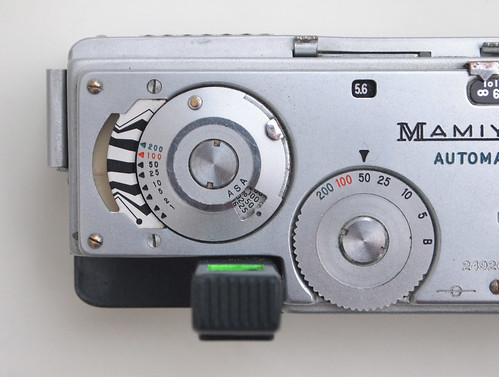 |
| Close up of the meter dial |
Other features of the camera include: a built-in filter, which slides over the lens, and can be changed by opening a cover on the underneath; PC socket for flash on the underneath of the camera; a tripod socket on both the bottom plate as well as on the side, located on the accessory shoe, which doubles as a fixing for the camera's wrist strap; and a film reminder above the wind on, with "Color/Black & White/Empty" printed on it.
The original Mamiya-16 camera used two metal cartridges, with the 16mm film travelling from one cartridge on the feed side into a second on the take-up side, meaning that the film doesn't need to be rewound once shot, and the empty supply-side cartridge is then transferred to the take-up chamber. The Mamiya-16 Automatic was designed for a new two chamber cartridge, not dissimilar to that of the 110 format, but the camera was still compatible with the earlier single cartridges. My example of the camera had a two chambered cartridge inside when I bought it, but I also found a pair of original single cartridges for the camera. The two chambered cartridge has spooless supply side, into which 45mm/18 inches film fits, taped to the take up spool in the other side. The Mamiya-16 Automatic's frame counter goes up to 20, but I've found that it's fairly easily to shoot 24 frames in practice, although with a longer length of film it becomes too stiff to advance (as the supply chamber doesn't have a spool, more film will fit into this than the chamber with the spool). Incidentally, the frame counter is not automatically reset when loading/unloading, the manual instructs the user to advance the empty camera to 18, helpfully picked out in red, and after loading, to take two shots to be ready to shoot the film.
 |
| Mamiya-16 Cartridges |
For the first few test rolls that I shot with the Mamiya-16 Automatic, I used 35mm
Rollei ATO 2.1, cut down to 16mm width using a ruler and craft knife, as, due to being orthochromatic, it's easy to do so under a red safelight (also loading the camera under a safelight means not losing the first couple of frames due to exposing the film when loading). I developed the film by taping it, emulsion side outwards, to some unwanted 35mm film and used standard Paterson spirals and tanks to process the film (dedicated 16mm tanks for subminiature cameras were produced, but without one this is the easiest way to develop the film, although I did have to untape it from the 35mm film to fully wash out the antihalation backing once developed and fixed).
 |
| Rollei ATO 2.1 (scan from print) |
I was disappointed with the quality of the results of scanning my first negatives, as the flatbed scanner I was using is not quite capable of resolving the fine detail of the film; this is much less noticeable in larger formats of course. I made some prints on Ilford MG paper instead from some of the negatives of the first couple of films shot in the Mamiya-16 Automatic (I rarely print my photographs these days, almost all the images on this blog and my Flickr photostream are scanned from the negatives for convenience). One of the things that I wanted to do with the first couple of films I shot was to test the camera's
ability to focus down to 1 foot. To do so, I photographed a page from a type catalogue, seen below, and measured the distance to the film
plane indicator on the camera with a ruler for accuracy, necessary for close focus. The type size at the top of the page is 6pt;
with close focus, there is considerable parallax error, and although there are marks in the finder to indicate this, it's a good idea to make sure the
important parts of the composition are in the lower right portion of the viewfinder: in my shot of the type catalogue I had thought that the top of the page with the name of the typeface was included (Garamond, incidentally). This ability to close focus the Mamiya-16 Automatic also just happens to tally with the association of subminiature cameras to espionage in the popular imagination: as well as being small enough for easy concealment, it's also perfect for copying plans and documents.
 |
| Rollei ATO 2.1 (scanned from print) |
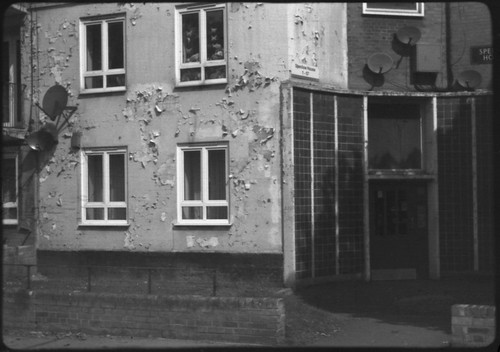 |
| Rollei ATO 2.1 (scanned from negative) |
 |
| Rollei ATO 2.1 (scanned from negative) |
Having successfully shot a few rolls of the cut down Rollei ATO 2.1 film, I bought some 16mm film to use in the camera, not wanting to rely on being able to cut film to the correct width in the darkroom. 16mm film is still widely available, thanks to the format being
used for movie cameras. For motion picture purposes, 16mm film comes in
a number of lengths, the shortest being 100ft/30.5m, and it's available
unperforated, and single and double perforated. When using single
perforated 16mm, it's advisable to ensure the perforations run at the
top of the images, as there's a wider rebate to the negatives at the top,
which leads me to think that the camera was designed to accept single
perforated film, although the perforations aren't used to advance the frames. As the image projected inside the camera is reversed
top-to-bottom, in practice this means the perforated edge is nearest to
the bottom plate. In the plastic two chambered cartridge, the perforated
edge runs next to the plastic bridge between the two chambers.
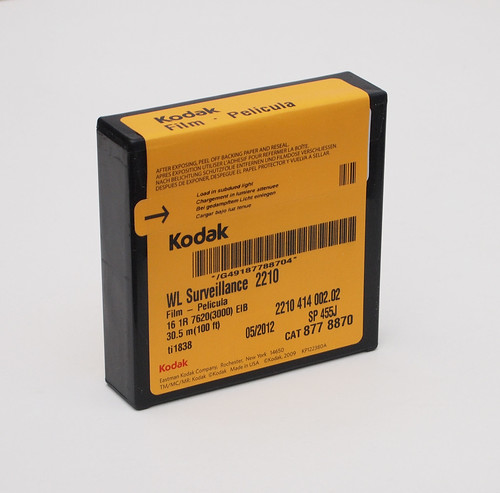 |
| Kodak WL Surveillance 2210 film |
From a well-known online auction site, I purchased a roll of 16mm
Kodak WL Surveillance 2210 film, a fast film with wide exposure latitude. Even accounting for plenty of wastage, 100ft of film should provide well over 50 cartridges of film, making each very cheap (I paid £15.50 for the film). I rated the film at 400, and stand developed it in Rodinal 1:100 for one hour. The first test of the WL Surveillance film was largely spoilt
by a light leak thanks to the top cap of the plastic cassette staying in the camera body when I pulled the cartridge out, a reminder to be more careful to put tape around the caps to hold these in place. By contrast, the metal cassettes have ball locks on the caps on either end, as well as being heavier, so they drop out of the camera with greater ease.
 |
| Kodak WL Surveillance film |
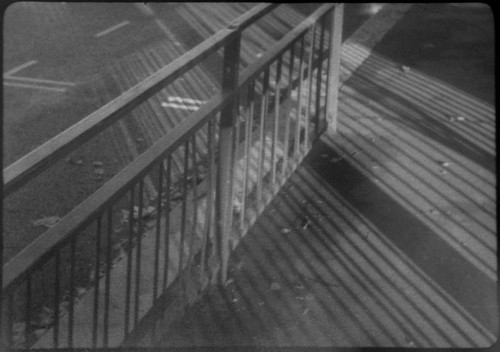 |
| Kodak WL Surveillance film |
The results from the Kodak WL Surveillance film inevitably display more pronounced grain than the Rollei ATO film, but the film's faster speed, latitude and longer tonal scale balance this for purposes of ease of use. As is common to subminiature cameras as a format, the ratio of a small frame
size to the size of film grain and its resolving power is large determinant of subminiature image quality. However, these cameras were made with portability and economy of film as priorities, long before the emergence of compact 35mm cameras such as the Minox 35 removed one of their chief attractions. Using 16mm subminiature cameras today, the main stumbling block is not the availability of film, but the different cassettes for each brand of camera: compared to the Mamiya-16 series, the Minolta-16 cameras appear less scarce and also had the dubious honour of having an Eastern Bloc copy, the
Kiev Vega (it strikes me that making new proprietary cassettes could be one niche the much-forecasted 3D printer revolution could be good for). 16mm subminiature cameras also retain an advantage over the 110 format in the fact that, although the 110 cartridge also uses 16mm film, it has its own arrangement of perforations, and it's much more difficult replicate this as opposed to using 16mm film or cutting down other sizes.
Sources/further reading:
Mamiya-16 Automatic on Camera-Wiki
Mamiya-16 review on Dominic's Classic Cameras
Mamiya-16 cameras on Submin.com
The Subclub page on the Mamiya-16 Automatic











This comment has been removed by a blog administrator.
ReplyDeleteI´m looking for this cassettes, do you know if its possible print in a 3d printer?
ReplyDeleteI imagine this would be possible - I've haven't seen anywhere that someone's done this and/or posted the code, but it seems that this would be an ideal use for the technology.
Delete